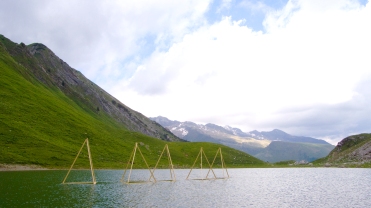 [ENG]
[ENG]
Recalling the stereotype of the mountain skyline by means of primitive wooden structures leads to a reflection about the abstract idea of mountain, and about more general issues involving time and space. The disposition of the wooden tetrahedrons, floating on water, is unstable and changing, in the same way we experience different landscapes not only in reality, depending on our point of view, but also in our memory, which makes the distance among points in spaces an time smaller or bigger, based on our momentary mental conditions. The concept of mountain as a fixed object, a mandatory requisite for the consistency of a map as a valuable description of reality, is overcome: the mountain is still represented by a symbol, but this symbol itself, undergoing a metamorphosis in its spatial and perspectival dimensions, negates its own adherence to reality and becomes a poetic element. The symbol, as a “signifier”, simplifies as much as possible the represented object — the tetrahedron is the simples tridimensional figure — and at the same time becomes a wooden frame through which to look at the real, “signified” object. A further short-circuit is then established between frame and picture, between real object and symbol, between container and content.
[ITA]
Il lavoro gioca con il concetto astratto di montagna, riconcretizzato in forme primitive di legno. L’idea è quella di riprodurre lo stereotipo del profilo del paesaggio montano, riflettendo allo stesso tempo su alcune problematiche relative allo spazio e al tempo: la disposizione delle forme è variabile e cangiante, così come per la nostra percezione il paesaggio cambia non solo nella realtà, insieme al nostro punto di vista, ma anche nella nostra memoria (in cui i punti nel tempo e nello spazio si avvicinano e si allontanano in base alle contingenze mentali del momento). Viene meno, dunque, la fissità dell’oggetto-montagna, requisito necessario per la stesura di una mappa: la montagna è sì rappresentata da un simbolo, ma è il simbolo stesso, cambiando i propri rapporti spaziali e prospettici, a negare la propria adesione alla realtà, diventando elemento poetico e non semplicemente “segno”. Il simbolo semplifica al massimo l’idea dell’oggetto rappresentato – il tetraedro è la più elementare figura tridimensionale – e contemporaneamente diventa una cornice vuota, attraverso cui si può guardare l’oggetto reale, il significato. Si crea così un ulteriore corto circuito tra cornice e rappresentazione, tra oggetto reale e simbolo, tra contenitore e contenuto.
Making of:
Thanks to: Rifugio Branchino: Milena/Omar/Simone/Claudio, CAI Bergamo, Comune di Bergamo, Enrico Perini, Halldor Ulfarsson…
Taglio legno: FTC Terraneo Cucciago
